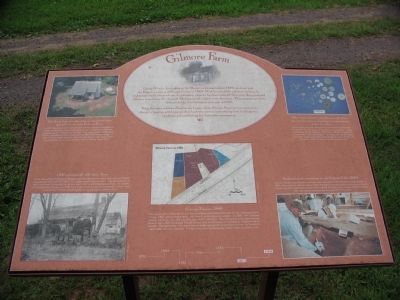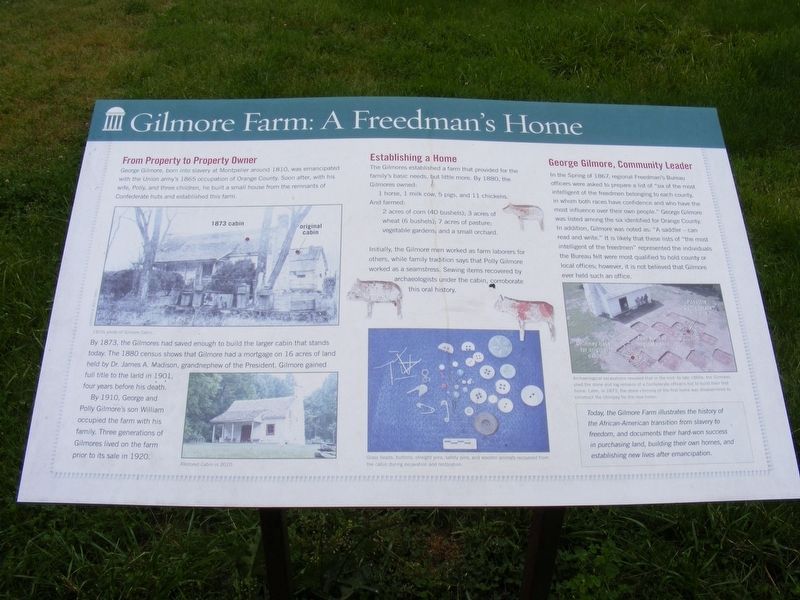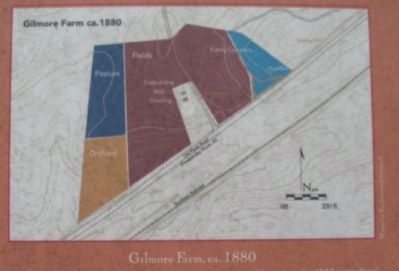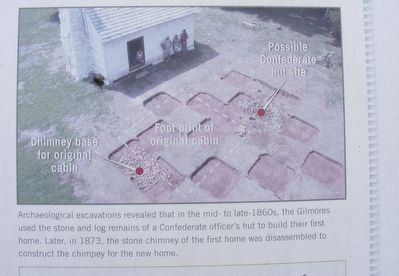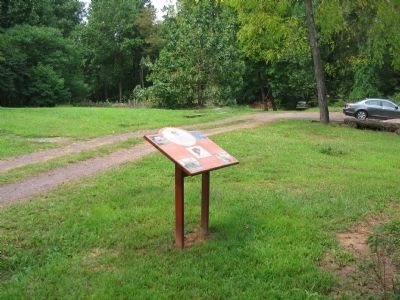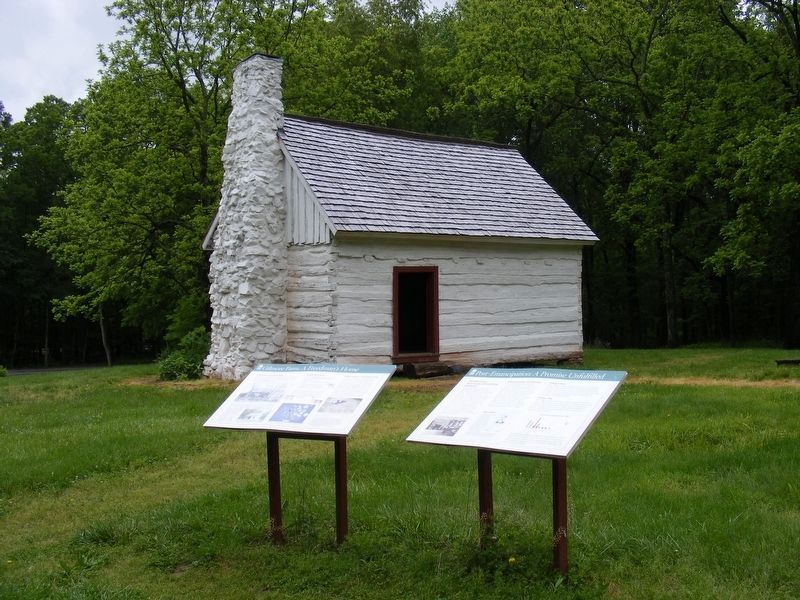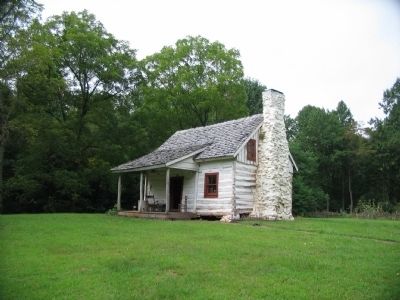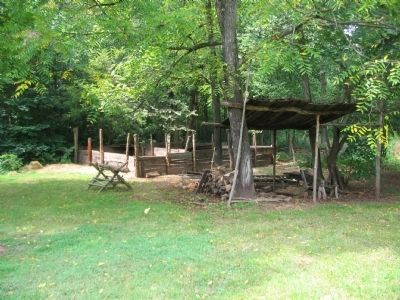Near Montpelier Station in Orange County, Virginia — The American South (Mid-Atlantic)
Gilmore Farm
A Freedman's Home
Today, the cabin and farm illustrate the history of the African-American transformation from slavery to freedom, and document their hard-won success in purchasing land, building their own home, and establishing new lives after emancipation.
Gilmore Farm, ca. 1880
The layout of the Gilmores' 16-acre farm has been reconstructed based on the 1880 agricultural census, 1937 aerial photography, and recent archaeological surveys. In 1880, the Gilmores owned one horse, one milk cow, five pigs, and 11 chickens. They farmed 12 acres, planting two acres in corn, which produced 40 bushels that year, and three acres in wheat, which produced six bushels. The remaining seven acres were probably planted in vegetables and fruit for the family and fodder for their livestock. The farm provided for the family's basic needs, but little more.
Overhead shot of archaeological excavation units open in yard of the Gilmore Farm
In 2002, Montpelier archaeologists discovered a series of cobblestone surfaces in the yard. Confederate Army artifacts were found with them suggesting the cobblestone surfaces may have been constructed by the Confederate Army as part of the 1863-1864 winter camp. A camp hut may have served as the Gilmore family's first home after emancipation, since they built their cabin in the spring of 1873.
1920s photograph of Gilmore Farm
At the time of this photograph, George and Polly Gilmore had died and their son William occupied the farm with his family. He made several improvements, enlarging the home with a one-room frame addition, planting an orchard, and keeping bee hives. As citizens and landowners, George and Polly were able to pass on the achievements of their hard work to their children, enabling them to build more successful lives.
Glass beads, buttons, straight pins and safety pins recovered by archaeologists in excavations under the cabin
These items had fallen through the florboards of the cabin during the first 30 years of the Gilmore occupation. They corroborate family tradition that Polly Gilmore worked as a seamstress and dressmaker. Earning cash to purchase necessary supplies was the responsibility of every member of the family, whether male or female, young or old.
Archaeological excavations inside Gilmore Cabin, 2001
Gilmore family descendants have kept their connection with the family homestead. In 2001, they volunteered their time to help Montpelier archaeologists conduct excavations inside the cabin, helping to recover the hundreds of beads, pins, buttons, and other items that had slipped between the floorboards of the cabin.
Topics. This historical marker is listed in these topic lists: African Americans • Agriculture. A significant historical year for this entry is 1810.
Location. This marker has been replaced by another marker nearby. It was located near 38° 13.595′ N, 78° 10.891′ W. Marker was near Montpelier Station, Virginia, in Orange County. Marker was on Constitution Highway (State Highway 20), on the right when traveling west. Located on a the Civil War Encampment walking trail on the Montpelier Estate. Touch for map. Marker was in this post office area: Orange VA 22960, United States of America. Touch for directions.
Other nearby markers. At least 8 other markers are within walking distance of this location. A different marker also named Gilmore Farm (within shouting distance of this marker); Post-Emancipation (within shouting distance of this marker); Gilmore Family Cemetery (about 400 feet away, measured in a direct line); Dolley Madison (about 400 feet away); Confederate Encampment (about 700 feet away); Civil War Encampment (approx. 0.3 miles away); Montpelier Train Station (approx. 0.3 miles away); Montpelier Flag Stop (approx. 0.3 miles away). Touch for a list and map of all markers in Montpelier Station.
Additional commentary.
1.
Note To Editor only visible by Contributor and editor
— Submitted May 13, 2017, by Pete Payette of Orange, Virginia.
Credits. This page was last revised on May 22, 2017. It was originally submitted on November 7, 2009, by Craig Swain of Leesburg, Virginia. This page has been viewed 1,285 times since then and 34 times this year. Last updated on May 13, 2017, by Pete Payette of Orange, Virginia. Photos: 1. submitted on November 7, 2009, by Craig Swain of Leesburg, Virginia. 2. submitted on May 13, 2017, by Pete Payette of Orange, Virginia. 3. submitted on November 7, 2009, by Craig Swain of Leesburg, Virginia. 4. submitted on May 13, 2017, by Pete Payette of Orange, Virginia. 5. submitted on November 7, 2009, by Craig Swain of Leesburg, Virginia. 6. submitted on May 13, 2017, by Pete Payette of Orange, Virginia. 7, 8. submitted on November 2, 2009, by Craig Swain of Leesburg, Virginia. • Bill Pfingsten was the editor who published this page.
